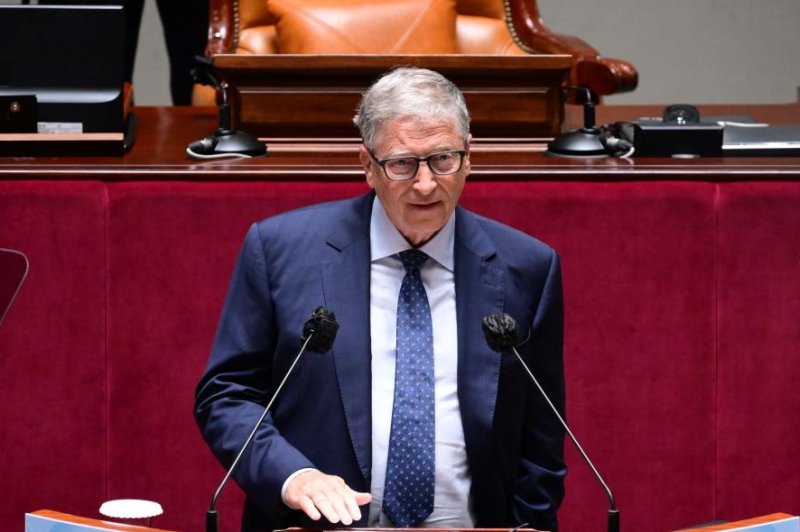'Das Boot,' 'Perfect Storm' director Wolfgang Petersen dies

Wolfgang Petersen died Tuesday of pancreatic cancer.
Aug. 16 (UPI) -- Director Wolfgang Petersen died Tuesday at age 81. His production company confirmed the news to Variety.
Deadline added that Petersen died of pancreatic cancer. He died in his Brentwood, Calif., home in his wife's, Maria Antoinette, arms.
After directing German film and television in the '60s and '70s, Petersen's 1981 film Das Boot brought him international acclaim. The story of a German U-Boat in WWII exists in a theatrical and director's cut, and a further extended TV miniseries version.
Petersen's next German production was the English-language family film The Neverending Story. The tale of a boy reading and interacting with the characters in a storybook brought Petersen to Hollywood.
Hollywood films like Enemy Mine and Shattered followed. Petersen directed Clint Eastwood's first starring role after his Unforgiven Oscar win with In the Line of Fire.
The film showed Eastwood as a Secret Service agent in his '60s. Having failed to stop John F. Kennedy's assassination, the agent gets a chance at redemption when he faces a new assassin (John Malkovich).
Petersen directed the hits Outbreak and Air Force One. The Perfect Storm was a blockbuster of the Summer of 2000, and pioneered visual effects that created the giant wave.
Petersen had another hit with the mythological epic Troy starring Brad Pitt as Achilles. Poseidon, a remake of The Poseidon Adventure, was his last Hollywood movie.
Petersen's last film was the 2016 German film Vier Gegen die Bank, or Four Against the Bank. It was his first German-language film since Das Boot.

1 of 4
NEW YORK (AP) — Wolfgang Petersen, the German filmmaker whose World War II submarine epic “Das Boot” propelled him into a blockbuster Hollywood career that included the films “In the Line of Fire,” “Air Force One” and “The Perfect Storm,” has died. He was 81.
Petersen died Friday at his home in the Los Angeles neighborhood of Brentwood after a battle with pancreatic cancer, said representative Michelle Bega.
Petersen, born in the north German port city of Emden, made two features before his 1982 breakthrough, “Das Boot,” then the most expensive movie in German film history. The 149-minute film (the original cut ran 210 minutes) chronicled the intense claustrophobia of life aboard a doomed German U-boat during the Battle of the Atlantic, with Jürgen Prochnow as the submarine’s commander.
Heralded as an antiwar masterpiece, “Das Boot” was nominated for six Oscars, including for Petersen’s direction and his adaptation of Lothar-Günther Buchheim’s best-selling 1973 novel.
Petersen, born in 1941, recalled as a child running alongside American ships as they threw down food. In the confusion of postwar Germany, Petersen — who started out in theater before attending Berlin’s Film and Television Academy in the late 1960s — gravitated toward Hollywood films with clear clashes of good and evil. John Ford was a major influence.
“In school they never talked about the time of Hitler -- they just blocked it out of their minds and concentrated on rebuilding Germany,” Petersen told The Los Angeles Times in 1993. “We kids were looking for more glamorous dreams than rebuilding a destroyed country though, so we were really ready for it when American pop culture came to Germany. We all lived for American movies, and by the time I was 11 I’d decided I wanted to be a filmmaker.”
“Das Boot” launched Petersen as a filmmaker in Hollywood, where he became one of the top makers of cataclysmic action adventures in films spanning war (2004′s “Troy,” with Brad Pitt), pandemic (the 1995 ebolavirus-inspired “Outbreak”) and other ocean-set disasters (2000′s “The Perfect Storm” and 2006′s “Poseidon,” a remake of “The Poseidon Adventure,” about the capsizing of an ocean liner).
But Petersen’s first foray in American moviemaking was child fantasy: the enchanting 1984 film “The NeverEnding Story.” Adapted from Michael Ende’s novel, “The NeverEnding Story” was about a magical book that transports its young reader into the world of Fantasia, where a dark force known as the Nothing rampages.
Arguably Petersen’s finest Hollywood film came almost a decade later in 1993’s “In the Line of Fire,” starring Clint Eastwood as a Secret Service agent protecting the president of the United States from John Malkovich’s assassin. In it, Petersen marshalled his substantial skill in building suspense for a more open-air but just as taut thriller that careened across rooftops and past Washington D.C. monuments.
Seeking a director for the film, Eastwood thought of Petersen, with whom he had chatted a few years earlier at a dinner party given by Arnold Schwarzenegger. Eastwood met with Petersen, checked out his work and gave him the job. “In the Line of Fire” was a major hit, grossing $177 million worldwide and landing three Oscar nominations.
“You sometimes have seven-year cycles. You look at other directors; they don’t have the big successes all the time. Up to ‘NeverEnding Story,’ my career was one success after another,” Petersen told The Associated Press in 1993. “Then I came into the stormy international scene. I needed time to get a feeling for this work -- it’s not Germany anymore.”
Petersen considered the political thriller — which cast the heroic Eastwood as the tired but devoted defender of a less honorable president — an indictment of Washington.
“When John’s character says, ‘Nothing they told me was true and there’s nothing left worth fighting for,’ I think his words will resonate for many people,” Petersen told The Los Angeles Times. “The film is rooted in a profound pessimism about what’s unfortunately happened to this country in the last 30 years. Look around — the corruption is everywhere, and there’s not much to celebrate.”
After “Outbreak,” with Dustin Hoffman, Rene Russo and Morgan Freeman, Petersen returned to the presidency in 1997′s “Air Force One.” Harrison Ford starred as a president forced into a fight with terrorists who hijack Air Force One.
“Air Force One,” with $315 million in global box office, was a hit, too, but Petersen went for something even bigger in 2000′s “The Perfect Storm,” the true-life tale of a Massachusetts fishing boat lost at sea. The cast included George Clooney and Mark Wahlberg but its main attraction was a 100-foot computer-generated wave. With a budget of $120 million, “The Perfect Storm” made $328.7 million.
For Peterson, who grew up on the northern coast of Germany, the sea long held his fascination.
“The power of water is unbelievable,” Petersen said in a 2009 interview. “I was always impressed as a kid how strong it is, all the damage the water could do when it just turned within a couple of hours, and smashed against the shore.”
Petersen’s followed “The Perfect Storm” with “Troy,” a sprawling epic based on Homer’s Iliad that found less favor among critics but still made nearly $500 million worldwide. The big-budget “Poseidon,” a high-priced flop for Warner Bros., was Petersen’s last Hollywood film. His final film was 2016′s “Four Against the Bank” a German film that remade Petersen’s own 1976 German TV movie.
Petersen was first married to German actress Ursula Sieg. When they divorced in 1978, he married Maria-Antoinette Borgel, a German script supervisor and assistant director. He’s survived by Borgel, son Daniel Petersen and two grandchildren.




















